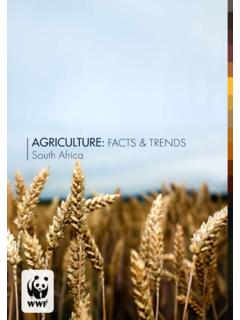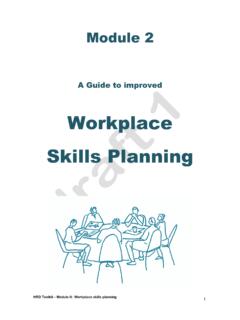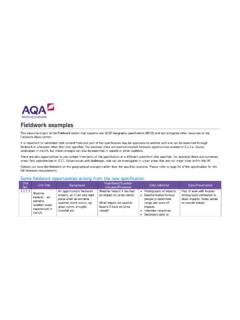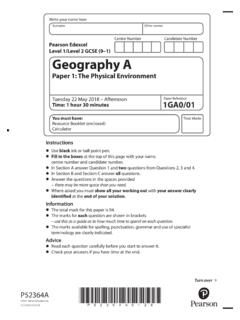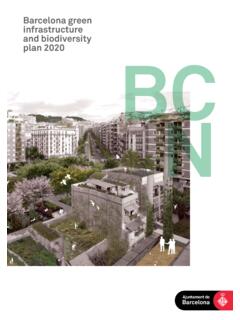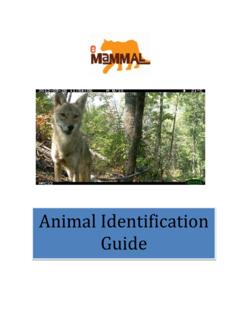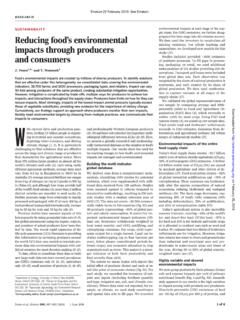Transcription of An introduction to SOUTH AfRICA’S WATER SOURCE AREAS
1 TOGETHER. INVESTING IN THE. FUTURE OF SOUTH . africa 'S MARINE. AND FRESHWATER. ecosystems . REPORT. ZA. 2013. An introduction to SOUTH africa 's WATER SOURCE AREAS The 8% land area that provides 50% of our surface WATER WATER doesn't come Hougaard Malan from a tap, noT even a dam ~. If we as SOUTH Africans wish to meet our common aspirations of social and economic development, we will need to act decisively to prioritise the management of our WATER resources and the ecosystems that provide us with WATER . In terms of the supply of WATER , we will need to embrace the fundamental concept that WATER does not come from a tap, not even a dam; WATER is provided to us by healthy and functioning ecosystems .
2 Contents Foreword WWF SOUTH africa CEO 6. introduction 8. SOUTH africa 's freshwater resources and ecosystems 10. Map of SOUTH africa 's WATER SOURCE AREAS 12. SOUTH africa 's WATER SOURCE AREAS 14. Threats To Our WATER SOURCE AREAS 16. Western Cape WATER SOURCE AREAS 18. Contributors Groot Winterhoek Table Mountain 20. 21. Boland Mountains 22. WWF SOUTH africa Langeberg Mountains 24. Christine Colvin, Sindiswa Nobula, Imelda Haines Swartberg Mountains 25. Kougaberg Mountains 26. Outeniqua Mountains 27. Council for Scientific & Industrial Research (CSIR). Jeanne Nel, Dave Le Maitre, Janis Smith Eastern Cape WATER SOURCE AREAS 28. Tsitsikamma 30.
3 Amatole 31. Eastern Cape Drakensberg 32. Pondoland Coast 33. Maloti Drakensberg 34. Production Editorial team: Eitan Prince & Sindiswa Nobula KwaZulu-Natal WATER SOURCE AREAS 36. Design: Anthea Forlee Northern Drakensberg 38. Southern Drakensberg 39. Printing: RSA Litho Mfolozi Headwaters 40. Zululand Coast 41. Cover page photographer Hougaard Malan MPUMALANGA WATER SOURCE AREAS 42. Mpumalanga Drakensberg 44. Funded by Sanlam Mbabane Hills 45. Ekangala Drakensberg 46. Text 2013 WWF-SA. Acknowledgements are due to the Department of WATER Affairs, in particular staff from the Directorate of Strategic WATER Resource LIMPOPO WATER SOURCE AREAS 48.
4 Planning, whose input and advice were gratefully received, and the Wolkberg 50. Department of Environmental Affairs. Soutpansberg 51. Protecting SOUTH africa 's WATER SOURCE AREAS 54. Further technical details on SOUTH africa 's WATER SOURCE AREAS can be found in the accompanying report Defining SOUTH africa 's WATER SOURCE AREAS , 2013; WWF-SA. SOUTH africa 's WATER by numbers 55. For more information on SOUTH africa 's WATER SOURCE AREAS please visit An introduction to SOUTH africa 's WATER SOURCE AREAS | page 4 An introduction to SOUTH africa 's WATER SOURCE AREAS | page 5. Hougaard Malan Foreword Nelson Mandela's words calling for a just and sustainable SOUTH africa are etched on Yasser Booley / WWF-SA.
5 Our national consciousness: Let there be justice for all. Let there be peace for all. Let there be work, bread, WATER and salt for all. Achieving that balance of work, bread and WATER for all in our process of development remains a core challenge for government, business and citizens alike. WATER is an absolute necessity to meet our most basic human needs as well as to grow our economy. SOUTH africa is a WATER -scarce country, and our development has always been constrained by our ability to overcome the difficulties of ensuring that WATER supplies are available where and when we need them. Our history shows us heroic episodes of redesigning nature: building dams and constructing ambitious schemes to transfer WATER to our major urban centres and to Gauteng located on a WATER divide between the mighty Orange and Limpopo river basins, high and dry on the Highveld.
6 This engineered infrastructure, built over the last century, brought WATER to drier AREAS , enabling agricultural and industrial development. The last decade has seen a focus on supplying more SOUTH African households with safe, reliable drinking WATER and bringing taps to homes and settlements that were previously marginalised. But on this mission to dam and deliver WATER , we have lost sight of where our WATER comes from and the critical role of nature in ensuring WATER for all. Although critical in the WATER supply chain, engineered infrastructure cannot deliver if we do not take care of the ecological infrastructure - the catchments, rivers and aquifers - that feed our dams and WATER schemes.
7 Recent research by WWF SOUTH africa and the Council for Scientific and Industrial Research (CSIR), with funding from Sanlam, mapped out SOUTH africa 's strategic WATER sources AREAS - the crown jewels' of the country's WATER resources. This research found that only 8% of the land area of SOUTH africa generates more than half of our river flow. These findings and this report further remind us that our WATER doesn't come from a tap (or from a dam for that matter). To achieve the balance between work, bread and WATER for all' our WATER SOURCE AREAS need special attention. We need to plan strategically for development in these AREAS to protect their ability to deliver WATER to the rest of the country.
8 This episode of our development requires heroic and far-sighted acts to protect these precious natural assets and ensure that future generations of SOUTH africa inherit a healthy landscape that can provide them with WATER security. WWF's vision is to inspire people to live in harmony with nature. We need to plan and build our future economic growth in harmony with our WATER SOURCE AREAS . We hope that through this work, SOUTH Africans will develop a better understanding and appreciation of our country's WATER challenges, and our different roles in ensuring a WATER runs through WATER -secure future for our country. our every aspiration Morn du Plessis Chief Executive Officer: WWF SOUTH africa as a society ~.
9 Kader Asmal (1934 - 2011), former Minister of WATER Affairs and Patron of WWF SOUTH africa 's WATER Balance Programme. An introduction to SOUTH africa 's WATER SOURCE AREAS | page 6. introduction The availability of freshwater is MIKE TURNER. one of the major limiting factors to SOUTH africa 's development. We are a WATER -scarce country with rainfall distributed unevenly in our landscape, inconveniently away from the centers of mining and industry, and tied to seasonal cycles that drive us repeatedly from feast to famine, between floods and droughts. Our ingenuity as a nation has focused on overcoming these limitations bringing WATER to where we need it, storing it for when we need it, and enabling us to build our economy.
10 The 1930s and then the 1970s and 80s saw a massive investment in dams and inter-basin transfer schemes to meet the needs of our growing economy. A massive and expensive network of engineered infrastructure supplies the drier parts of the country. Gauteng, North West province and Limpopo, and major urban centers such as Durban, Port Elizabeth and Cape Town are supplied via dams, transfers and pumping schemes. The cost to upgrade and maintain this engineered infrastructure is estimated at R680. billion over the next decade. However, WATER doesn't just come from a dam, a pipe or a tap. Our modern WATER cycle is comprised of both engineered infrastructure and ecological infrastructure.
